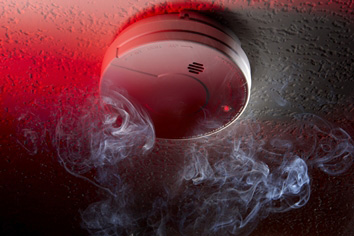Fighting fire with technology: Smart smoke alarms
Josh Monen
 Fire prevention technology has helped saved thousands of lives over the last 40 years. About 12,000 people died in fires each year in the late 1970s. Less than 10 years later, that number fell to about 6,000.
Fire prevention technology has helped saved thousands of lives over the last 40 years. About 12,000 people died in fires each year in the late 1970s. Less than 10 years later, that number fell to about 6,000.
However, seven people still die each day in U.S. home fires, on average, according to a 2013 report by the National Fire Protection Association NFPA).
In the past decade, there have been big advances in fire prevention technology. Could new “smart” smoke alarms help change this and save more lives?
We took a look at three smoke alarms — two new “smart” alarms and one traditional — to see how they compare.
Fast fires vs. smoky fires
George Baker, who served as fire chief for Mashpee Fire and Rescue for 20 years, says there are two types of home fires: “Fast-flaming fires, that produce a lot of flames but not much smoke; and smoldering fires, where there is a lot of smoke but not many flames.” According to the NFPA, fast-flaming fires are the most common types of home fires.
And not every smoke alarm can effectively detect both types. Baker says fast-flaming fires are best detected by alarms with ionization detectors, while smoldering fires are best detected by alarms with photoelectric sensors.
Some alarms have both sensors but most people have alarms that only have ionization detectors.
If you want to find out what type of alarm you have, Baker recommends looking at the back of the device — it’s usually stamped on the back of the alarm.
“However, if you can’t find it, another way to find out is to see if the alarm instructs you to not throw it away and return it to the company,” Baker says. “If it says this on the back, then it’s probably an ionization alarm.”
The NFPA recommends using both ionization and photoelectric technologies in the home.
New types of fire prevention technology
Nest Protect
Nest Labs, a home automation company headquartered in Palo Alto, CA that makes “smart” thermostats and smoke alarms for homes, offers an Internet-connected smoke and carbon monoxide alarm called the Nest Protect.
The device offers user-friendly features such as alerts on your smartphone and voice guidance directly from the alarm.
Alexandra Zoz Cuccias, head of Nest’s Communications for Consumer Hardware, explains how the device works in conjunction with your smartphone.
“Nest Protect is Wi-Fi enabled and connects to your mobile devices via the Nest app. Nest Protect will message you in case of emergency or if the batteries run low,” he says.
The device sells for $99 and can be purchased at Nest.com, Amazon.com and most home-goods stores. The Nest Protect uses a photoelectric sensor but doesn’t have an ionization detector.
Birdi
Similar to the Nest Protect, the Birdi is another smart smoke alarm. According to a New York Times interview with Mark Belinsky, Birdi’s co-inventor, the device is what he calls a “smart air monitor” that sniffs for smoke and also reports on pollutants and allergens in the home.
In addition to detecting smoke, the Birdi is able to sense temperature, CO2 level, carbon monoxide levels which the Nest Protect does too), humidity and particle density. Particle density is an important factor in detecting fog.
Like the Nest Protect, the Birdi uses a photoelectric sensor but doesn’t have an ionization detector.
The Birdi can send notifications to your smartphone when it’s out of power. Currently the Birdi is available for preorder on its website at GetBirdi.com for $119.
First Alert SA320CN
While the First Alert SA320CN is not a “smart” smoke alarm, it’s a dual-sensor smoke alarm. The device uses both ionization and photoelectric sensors, which means it can better detect both smoldering and fast-flaming fires.
The First Alert smoke alarm earns good scores in professional reviews and online user reviews, although there are some complaints of malfunctioning low-battery indicators.
The alarm sells for around $25 and can be purchased at Amazon.com and retailers such as Target.
Does having a smoke alarm save money on your home insurance?
You may be eligible for additional discounts on your homeowners insurance for certain types of smoke alarms.
Loretta Worters, a vice president at the Insurance Information Institute says, “protective device discounts provide a variety of ways to save on homeowners insurance. You can usually get discounts of at least 5 percent for a smoke detector, burglar alarm or dead-bolt locks.”
Worters adds, “Some companies may cut your premiums by as much as 15 or 20 percent if you install a sophisticated sprinkler system and a fire and burglar alarm that rings at the police, fire or other monitoring stations.”
Not every system qualifies for a discount, so call your insurance agent and ask.
The bottom line is that smoke detectors save lives. So even if you don’t buy a new one, it’s important to check your existing smoke alarms at least once a month to make sure they’re working.
And according to the NFPA, you should also make sure you have smoke alarms installed on every level of your home, including the basement, in every bedroom and outside each sleeping area.
Also check the back of the alarm to see if it’s an ionization alarm, a photoelectric alarm or an alarm with both sensors. If it doesn’t have both sensors now may be a good time to replace it.
See how much you could save today on your home insurance. Get your free home insurance quotes today!
